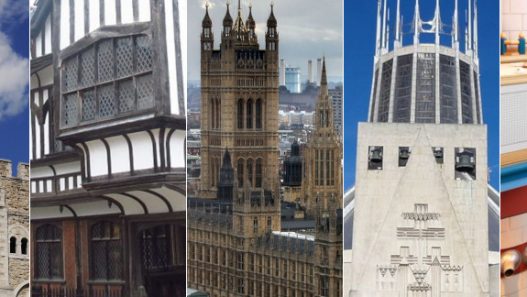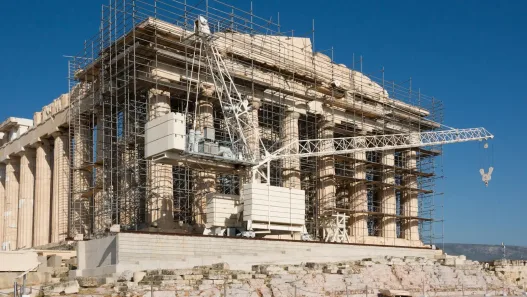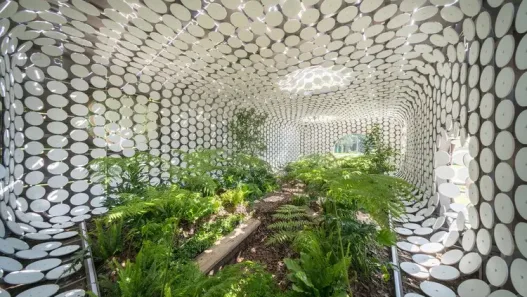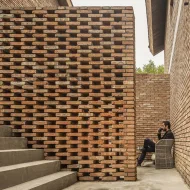High-altitude architecture, the art and science of building structures in the rarefied air of mountains and plateaus, presents a unique set of challenges and opportunities. This chapter delves into the fascinating world of high-altitude architecture, exploring its defining characteristics, historical context, key features, geographical implications and global trends.
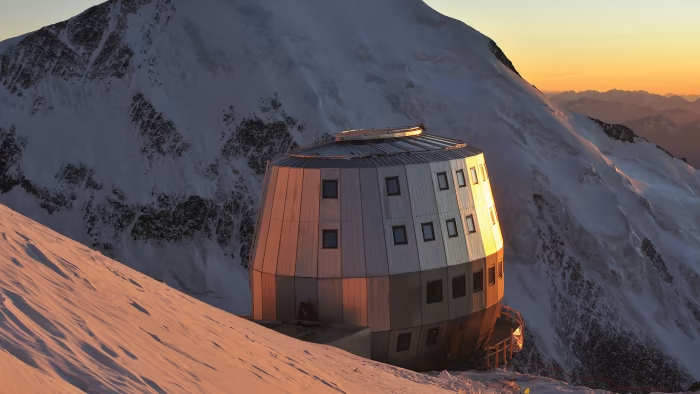
Identification of High Altitude Structures: Characteristics and Challenges
High-altitude structures are structures built significantly above sea level, typically above 2,500 metres (8,200 feet). These structures face unique challenges due to harsh environmental conditions:
- Thin Air: The reduced air pressure at high altitudes affects human physiology and requires specialised building techniques to ensure structural integrity.
- Extreme Temperatures: High altitude areas experience extreme temperature fluctuations, requiring buildings to be designed for both cold winters and hot summers.
- Strong Winds:Strong winds are common at high altitudes, requiring robust structures and wind-resistant designs.
- Limited Resources: Access to materials and resources can be limited in remote high altitude locations, requiring innovative solutions for construction.
Historical Context of High Altitude Architecture: A Timeline of Development
High altitude architecture has a long and fascinating history with civilisations adapting to harsh environments over the centuries:
- Ancient Civilisations:Ancient cultures in the Andes, Himalayas and Tibetan Plateau developed unique architectural styles to withstand harsh conditions and create sustainable communities.
- Medieval Monasteries: Medieval monasteries were often built at high altitudes for spiritual retreat and isolation, demonstrating innovative building techniques for cold climates.
- Modern Mountain Resorts: The 20th century saw the rise of modern mountain resorts, using advanced technologies and materials to create comfortable and luxurious accommodation in high altitude environments.
Basic Characteristics of High Altitude Design: Functionality and Aesthetics
High-altitude architecture is characterised by specific design features that address the unique challenges of these environments:
- Compact Design: Buildings are generally compact and efficient to minimise heat loss and wind resistance.
- Insulation: Thick insulation is essential to protect against extreme temperatures and reduce energy consumption.
- Ventilation: Proper ventilation is essential to prevent moisture accumulation and provide comfortable living conditions.
- Solar Design: Passive solar heating and daylighting are often used to maximise energy efficiency and reduce dependence on fossil fuels.
The Role of Geography in Shaping High Altitude Architecture
The geographical context plays an important role in shaping high-altitude architecture:
- Terrain: The steep slopes and rugged terrain of mountainous regions influence building design and often require innovative structural solutions.
- Climate: The unique climate of high-altitude regions, with its thin air, extreme temperatures and strong winds, dictates the choice of materials, building techniques and design features.
- Local Resources: The availability of local materials, such as stone, wood and soil, influences architectural style and construction methods.
Global Trends in High Altitude Building Practices
Global trends in high-altitude building practices are driven by growing interest in sustainable development, adaptation to climate change and the search for unique architectural experiences:
- Sustainable Construction: The use of local materials, renewable energy sources and energy-efficient design principles are becoming increasingly common in high-altitude construction.
- Climate Resilient Design: Buildings are designed to withstand extreme weather events such as heavy snowfall, high winds and seismic activity.
- Architectural Innovation: Architects push the boundaries of design, creating innovative structures that blend seamlessly into the surrounding landscape and offer breathtaking views.
High-altitude architecture is a testament to human ingenuity and adaptability, demonstrating the ability to create functional and aesthetically pleasing structures in challenging environments. As we face challenges such as climate change and resource scarcity, lessons from high-altitude architecture can provide valuable insights into sustainable building practices and innovative design solutions for the future.
Engineering Challenges in High Altitude Structures
Building at high altitudes presents a unique set of engineering challenges that require innovative solutions to overcome harsh environmental conditions and ensure structural integrity. This chapter explores key engineering considerations in high-altitude architecture, highlighting the challenges and triumphs of building beyond the clouds.
Structural Integrity: Handling Forces and Loads in Extreme Conditions
High-altitude structures face significant forces and loads due to unique environmental conditions:
- Wind Loads: Strong winds at high altitudes can place great stress on buildings, requiring robust structural systems and wind-resistant designs.
- Seismic Activity: Mountainous regions are often prone to earthquakes and require structures that can withstand seismic forces.
- Snow Loads: Heavy snowfall can accumulate on roofs, requiring strong structural supports and snow-resistant designs.
- Thermal Expansion: Extreme temperature fluctuations can cause materials to expand and contract, requiring careful consideration of thermal expansion and contraction in structural design.
Material Selection: Selection of Suitable Sources for High Altitudes
The choice of materials for high altitude construction is very important because these materials must withstand extreme conditions and be readily available:
- Durability: Materials must be durable and resistant to weathering, UV radiation and temperature fluctuations.
- Strength: Materials should be strong enough to withstand high wind loads, seismic forces and snow accumulation.
- Insulation: Materials should provide adequate insulation to protect against temperature extremes and reduce energy consumption.
- Local Sourcing: Using locally sourced materials whenever possible reduces transport costs and supports local economies.
Environmental Considerations: Adapting to Weather and Climate Changes
High-altitude buildings should be designed to adapt to the unique weather and climate conditions of these environments:
- Solar Radiation: High-altitude areas receive intense solar radiation, which requires shading strategies and energy-efficient glazing to minimise heat gain.
- Moisture Management: Moisture accumulation can be a problem in cold climates, requiring proper ventilation and moisture-resistant materials.
- Snow and Ice Accumulation: Roof designs must be able to effectively retain snow and ice to prevent structural damage.
- Environmental Impact: Construction activities should be carefully planned to minimise environmental impact and protect the sensitive ecosystems of high altitude areas.
Vertical Transport: Innovations in Elevators and Access Systems
The vertical transport of people and materials in high altitude environments presents unique challenges:
- Altitude Effects: Reduced air pressure at high altitudes affects the performance of lifts and other vertical transport systems.
- Accessibility: Access roads and transport infrastructure can be limited in remote locations at high altitudes, requiring innovative solutions for transporting materials and equipment.
- Safety: Safety is paramount in high-altitude construction and requires rigorous safety protocols and specialised training for workers.
Case Studies: Significant High Altitude Structures and Engineering Solutions
A number of notable high-altitude structures showcase innovative engineering solutions:
- Burj Khalifa: The world’s tallest building in Dubai incorporates advanced structural engineering to withstand high wind loads and seismic activity.
- Matterhorn Mountain Railway: This iconic railway in Switzerland uses a unique rack and pinion system to navigate steep slopes and difficult terrain.
- International Space Station: Operating at an altitude of 400 kilometres (250 miles), this orbiting laboratory represents the pinnacle of engineering achievement in extreme environments.
The engineering challenges of high-altitude construction require creativity, innovation and a deep understanding of the unique forces and conditions at play. Engineers embrace these challenges, pushing the boundaries of structural design and creating extraordinary structures that stand as testament to the power of human ingenuity and engineering.
Aesthetic Dimensions of High Altitude Architecture
High altitude architecture is not just about overcoming engineering challenges; it is also about creating spaces that are visually stunning, culturally resonant and deeply connected to the surrounding landscape. This chapter explores the aesthetic dimensions of high altitude architecture, examining how design philosophy, integration with nature, symbolism, lighting and landscape contribute to the unique beauty and impact of these structures.
Design Philosophy: Balancing Form and Function in Vertical Spaces
High-altitude architecture often adopts a design philosophy that balances form and function, creating structures that are both visually striking and practical:
- Minimalism: The harsh conditions of high altitudes often require a minimalist approach, prioritising functionality and efficiency while minimising unnecessary ornamentation.
- Geometric Forms: Geometric forms such as triangles, squares and circles are often used to create strong and stable structures that can withstand harsh weather conditions.
- Verticality: The verticality of high-altitude structures is often emphasised, creating a sense of awe and wonder as they pierce the sky.
Integration with the Landscape: Harmonising Structures with the Natural Environment
High-altitude architecture seeks to harmonise with the surrounding landscape, creating a sense of unity between the built environment and nature:
- Organic Forms: Inspired by the natural world, organic forms are often used to create a sense of continuity between the building and its surroundings.
- Material Choices: Local materials such as stone, wood and earth are often used to blend the building with the landscape and create a sense of place.
- Window Placement: Strategic window placement creates a connection between indoors and outdoors, maximising views of the surrounding mountains and valleys.
Symbolism in Design: Representing Cultural Identity through Height
Buildings at high altitudes often carry symbolic meanings representing cultural identity, aspirations and the human desire to reach the heavens:
- Spiritual Significance: In many cultures, mountains are seen as sacred places, and buildings constructed at high altitudes often reflect this spiritual significance.
- Cultural Identity: High-altitude structures can embody the cultural identity of a region by showcasing traditional building techniques and materials.
- Human Achievement: The height of high-altitude structures can symbolise human achievement and the desire to push the boundaries of engineering and design.
Lighting and Landscape: Enhancing the User Experience in Elevated Spaces
Lighting and views play a crucial role in enhancing the user experience in high altitude spaces:
- Natural Light: Maximising natural light through large windows and skylights creates a bright and airy interior, reducing the need for artificial lighting.
- Night Views: Breathtaking views of the night sky illuminated by stars and city lights can be a mesmerising experience for those living in high-altitude structures.
- Interior Lighting: Strategic interior lighting can enhance the architectural features of the building and create a warm and inviting atmosphere.
Iconic High Altitude Buildings and Their Aesthetic Impact
Numerous iconic high-altitude buildings demonstrate the aesthetic power of this architectural style:
- Matterhorn Mountain Railway Station: Located in the Swiss Alps, this iconic railway station offers breathtaking views of the Matterhorn, blending seamlessly into the surrounding landscape.
- Burj Khalifa: Located in Dubai, the world’s tallest building is a testament to human ingenuity and architectural ambition, with its sleek and elegant design reaching for the sky.
- Meteora Monastery: Perched atop towering rock formations in Greece, these ancient monasteries are a testament to the spiritual significance of high-altitude architecture and its ability to inspire awe and wonder.
The aesthetic dimensions of high-altitude architecture are as important as its engineering achievements. By blending form and function, integrating with nature, embracing symbolism and maximising views and lighting, architects create spaces that are not only functional but also inspiring, awe-inspiring and deeply connected to the human spirit.
Environmental Impact of High Altitude Buildings
High altitude environments are often fragile ecosystems and sensitive to the impacts of human activities. While high-altitude architecture offers unique opportunities for design and innovation, it is crucial to consider the environmental impacts of these structures and strive for sustainable practices. This chapter examines the environmental considerations of high-altitude architecture, focusing on sustainability, energy efficiency, water management and waste minimisation.
Sustainability: Embedding Environmentally Friendly Practices in Design
Sustainable design principles are essential to minimise the environmental impact of high altitude structures:
- Local Materials: Using locally sourced materials reduces transport costs, supports local economies and minimises the environmental footprint of construction.
- Renewable Energy: Utilising renewable energy sources such as solar, wind and geothermal reduces reliance on fossil fuels and minimises greenhouse gas emissions.
- Passive Design: Using passive design strategies such as solar heating, natural ventilation and daylighting reduces energy consumption and dependence on mechanical systems.
- Green Building Standards: Complying with green building standards such as LEED or BREEAM ensures that buildings meet certain environmental performance criteria.
Energy Efficiency: Strategies to Reduce Consumption at High Altitudes
High-altitude environments present unique challenges for energy efficiency due to extreme temperatures and limited access to resources:
- Insulation: In cold climates, thick insulation is essential to minimise heat loss and reduce energy consumption for heating.
- Glazing: Energy-efficient glazing can optimise thermal performance by reducing heat gain in summer and heat loss in winter.
- Ventilation: Appropriate ventilation systems can minimise moisture accumulation and provide comfortable living conditions without the need for mechanical heating or cooling.
- Renewable Energy Integration: Integrating renewable energy sources such as solar panels or wind turbines can provide a sustainable power source for high-altitude buildings.
Water Management: Addressing Scarcity and Resource Utilisation
Water scarcity is a common problem in high altitude areas and requires careful water management strategies:
- Water Conservation: Implementing water-saving fixtures, appliances and landscaping practices can minimise water consumption.
- Rainwater Harvesting: Harvesting rainwater for irrigation and other purposes can reduce dependence on limited water resources.
- Wastewater Treatment: On-site treatment of wastewater can reduce the environmental impact of discharging untreated water into sensitive ecosystems.
- Water Efficient Design: Designing buildings with water efficient features such as grey water systems and water saving toilets can significantly reduce water consumption.
Waste Minimisation: Minimising the Environmental Footprint by Design
Minimising waste generation and promoting responsible waste management is crucial for the protection of high altitude environments:
- Construction Waste Minimisation: Implementing waste minimisation strategies such as using recycled materials during construction and minimising material waste can significantly reduce environmental impact.
- Waste Recycling and Composting: Establishing on-site recycling and composting programmes can divert waste from landfill and promote resource recovery.
- Sustainable Building Practices: Adopting sustainable building practices, such as using recycled materials and minimising the use of hazardous materials, can reduce the environmental footprint of construction.
High altitude architecture offers a unique opportunity to showcase the power of sustainable design and responsible development. By adopting environmentally friendly practices, minimising environmental impact and prioritising resource conservation, we can create structures that are not only resilient to the elements, but also exemplary of responsible management of our planet’s fragile ecosystems.
Social and Cultural Impacts of High Altitude Architecture
High altitude architecture is not just about buildings; it is also about the people who live in them and the communities they shape. This chapter explores the social and cultural impacts of high-altitude architecture, examining how these structures affect community engagement, public spaces, urban development, accessibility and the overall social fabric of high-altitude regions.
Community Engagement: Involving Local People in Design Processes
Involving local people in the design process is crucial to create high-altitude structures that are culturally appropriate and meet the needs of the community:
- Cultural Sensitivity: Designers should be sensitive to local customs, traditions and values and incorporate them into the design to create a sense of place and belonging.
- Community Input: Seeking input from local residents, community leaders and indigenous groups ensures that the design reflects the needs and aspirations of the community.
- Traditional Building Techniques: Preserving and incorporating traditional building techniques and materials can promote a sense of continuity and cultural heritage.
Public Spaces: Creating Spaces for Interaction and Gathering in Elevated Environments
High-altitude structures can play a vital role in creating public spaces that encourage social interaction and community building:
- Rooftop Gardens: Rooftop gardens can provide green spaces for relaxation, recreation and community gatherings, especially in densely populated urban areas.
- Observation Terraces: Observation terraces offer breathtaking views of the surrounding landscape, creating opportunities for shared experiences and a sense of wonder.
- Community Centres: High-altitude structures can host community centres, libraries and other public amenities, providing spaces for social interaction and cultural exchange.
Impact on Urban Development: High Altitude Structures and Urban Growth
High-altitude structures can shape the growth and character of cities by influencing urban development in high-altitude regions:
- Vertical Expansion: High-altitude structures can encourage vertical expansion, reducing the need for sprawling urban development and protecting valuable land.
- Density and Accessibility: High-altitude structures can make urban areas more accessible and efficient by creating high-density living spaces.
- Urban Renewal: High-altitude structures can revitalise existing urban areas, creating new opportunities for housing, commerce and public spaces.
Challenges of Accessibility: Ensuring Inclusion in Vertical Spaces
Ensuring accessibility for all members of the community is very important in high-rise buildings, especially those with vertical elements:
- Lifts and Ramps: Providing lifts and ramps for people with disabilities ensures that all members of the community can access all levels of the building.
- Universal Design: Applying universal design principles such as wide doorways, accessible toilets and clear signage makes buildings more inclusive for everyone.
- Transport Infrastructure: The development of accessible transport infrastructure, such as public transport and pedestrian routes, is essential to connect high-altitude structures to the surrounding community.
Social Impact of High Altitude Architecture on Communities
High altitude architecture can have a profound social impact on communities, shaping their identity, sense of place and overall well-being:
- Community Cohesion: High-altitude structures can foster a sense of community by providing common spaces for interaction and social gatherings.
- Cultural Preservation: The use of traditional building techniques and materials can help preserve cultural heritage and create a sense of continuity.
- Economic Development: High-altitude structures can stimulate economic development by creating jobs, attracting tourism and encouraging innovation.
High altitude architecture is not just about building structures; it is about building community. By embracing community engagement, creating inclusive public spaces, and considering the social and cultural implications of their designs, architects can create high-altitude structures that are not only functionally and aesthetically pleasing, but also contribute to the well-being and prosperity of the communities they serve.
The Future of High Altitude Architecture
High altitude architecture is constantly evolving with technological advances, changing environmental concerns and a growing desire to push the boundaries of design. This chapter explores the future of high-altitude architecture, examining emerging trends, technological developments and global perspectives on this fascinating field.
Emerging Trends: Innovations in Design and Construction Techniques
The future of high-altitude architecture is characterised by innovative design and construction techniques that address the unique challenges of these environments:
- Modular Construction: Modular construction techniques allow for faster and more efficient construction processes, reducing environmental impact and minimising disruption to sensitive ecosystems.
- Lightweight Materials: The use of lightweight materials such as composite materials and advanced alloys reduces the structural load on buildings, making them more resistant to high winds and seismic activity.
- 3D Printing: 3D printing technology is being explored for its potential to create complex and customised structures in high-altitude environments, reducing waste and minimising transportation costs.
- Biomimicry: Inspired by nature, architects are exploring biomimicry to create structures that are more durable, energy efficient and integrated with their surroundings.
Technological Developments: The Role of Smart Technologies in High Altitude Buildings
Smart technologies are playing an increasingly important role in high-altitude architecture by improving functionality, sustainability and user experience:
- Building Automation: Intelligent building systems can optimise energy consumption, manage lighting and temperature, and improve security, creating more efficient and comfortable living spaces.
- Renewable Energy Integration: Smart grids and energy storage systems can make high-altitude buildings more sustainable by facilitating the integration of renewable energy sources such as solar and wind power.
- Remote Monitoring: Remote monitoring systems can monitor building performance, identify potential problems and optimise operations, ensuring the safety and efficiency of high-altitude structures.
- Virtual Reality and Augmented Reality: Virtual reality and augmented reality technologies can be used to create immersive experiences for architects and clients, facilitating design collaboration and visualisation.
Global Perspectives: A Comparative Analysis of High Altitude Architecture Worldwide
High altitude architecture is a global phenomenon, with different regions developing unique approaches to design and construction:
- Himalayas: The Himalayas are home to a rich tradition of high-altitude architecture, with communities adapting to harsh conditions for centuries. Modern architects are taking inspiration from traditional building techniques and materials to create sustainable and culturally appropriate structures.
- Andes: The Andes is another region with a long history of high-altitude architecture, where indigenous communities have developed innovative solutions for building in difficult terrain. Modern architects are exploring the use of local materials and sustainable building practices to create structures that are both functional and environmentally sensitive.
- Alps: The Alps is a popular destination for mountain resorts and ski resorts and is encouraging innovation in high-altitude architecture. Architects focus on creating sustainable and energy-efficient structures that blend seamlessly with the surrounding landscape.
With an increasing focus on innovation, sustainability and cultural sensitivity, the future of high-altitude architecture is bright. By embracing new trends, technological advances and global perspectives, architects can create structures that are not only functionally and aesthetically pleasing, but also contribute to the well-being of societies and the protection of our planet’s fragile ecosystems.



